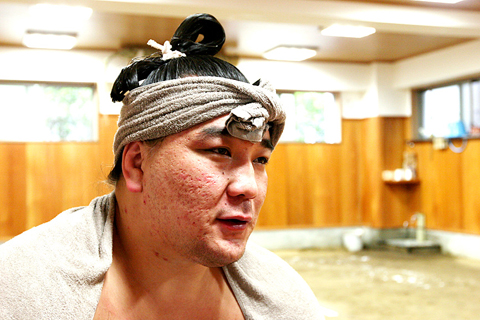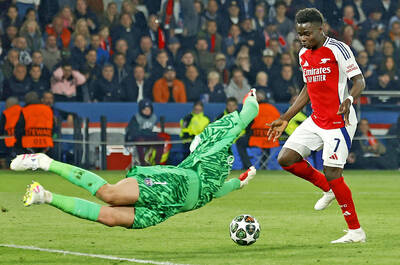The Japanese word kawaigari means “doting,” but in the grueling world of sumo it is an ironic euphemism for pushing a wrestler to the very limits of his physical and mental endurance.
It can include beatings with bamboo sticks and choking with sand or salt — and in one infamous case led to the death of a teenage recruit who had tried to flee the privations of his sumo stable.
Harumafuji, who last month won Japan’s major tournament, recalled the pain and tears that toughened him up in the nine years since he arrived from his native Mongolia with no money and not a word of Japanese.

PHOTO: AFP
“It’s a man’s world,” said the 25-year-old champion whose real name is Davaanyam Byambadorj, taking a rest with a sweatband around his head after a recent five-hour morning training session in his Tokyo stable.
“I had to get used to the bullying, beatings, hunger, and then the language and the culture which I did not understand,” he said, recalling how he was singled out for extra torment because he is a foreigner.
“It was rough,” he said. “It’s a world where you either become strong or not. In that sense, as much as it was painful, I felt very strongly that I would do my best to become strong as quickly as possible.”
In sumo, kawaigari means “crying, then being forced to stand, then being beaten again. It’s not simple to express with words because it’s a physical experience,” he said.
But it’s not just the beatings that steel the wrestlers in the quasi-monastic life of the sumo stable, where the fighters forfeit much of their personal liberty and embark on a grueling daily routine.
The younger wrestlers start the day at 3am cleaning the stable, washing their seniors’ loincloths and preparing meals. They are banned from watching television and using cellphones, and receive only modest pocket money.
Harumafuji said he found it toughest to get used to a diet heavy on fish — which has sent some of his mutton-eating compatriots running to the Mongolian embassy to escape Japan — served in huge quantities of 10,000 calories a day.
“Everyone says going on a diet is hard, but I think gaining weight is so many times more difficult,” he said. “Eating was the scariest, and my most painful experience.”
“I’m thin by nature, so I really had a hard time to eat in the beginning. I ate and I vomited. Ate and vomited. Your stomach expands when you do that, so I was forced to eat until I vomited,” Harumafuji said. “When I vomited, there would be someone already waiting with food, and I was forced to eat again.”
The force-feeding helped boost the 1.85m athlete’s weight to 126kg from 86kg — still about 30kg lighter than the average top division wrestler.
Harumafuji has no regrets.
“The sumo ring is very honest. He who really does his best will rise. Man’s efforts don’t lie,” he said. “I’m glad I did sumo, I am very grateful. I have learnt many things inside the ring, about life, the path I’ve chosen, about cherishing people.”
“Any punk who swaggers into a stable will change in one day. He will be cleaning the next day — cleaning toilets, crying. He’d be forced to lick the toilet bowl, because he’d be bullied,” Harumafuji said, smirking. “There are many obstacles, but if you’re able to get over them, you can become stronger than the others. If you rise up, everyone will follow you, thinking, ‘This guy’s tough.’”
Sumo may be as Japanese as samurai and sushi, but foreign-born wrestlers have entered the ring to steal the show in the 2,000-year-old national sport.
Sumo hasn’t had a home-grown champion in more than three years, and in the latest national tournament more than one-third of competitors were foreigners.
As fewer young Japanese sign up for the harsh life of the sumo stable, the sport’s 700-strong elite now include men from China, South Korea, Eastern Europe and as far away as Brazil and the Pacific island state of Tonga.
As sports such as baseball and soccer have gained ground, the number of Japanese sumo recruits has more than halved since its peak in 1992 of 223 local wrestlers.
Traditionally, young wrestlers were recruited from farming and fishing communities in the remote north and south, said Doreen Simmons, a veteran English-language sumo commentator for national broadcaster NHK.
Sumo opened its doors to foreigners decades ago, and spectators still delight when gaijin wrestlers exhibit what are seen by many as the essential Japanese characteristics of modesty, endurance and diligence.
The presence of foreigners will not lead to the internationalization of the sport, Simmons said, as the newcomers must assimilate, learn Japanese and adapt to the local diet, dress, customs and training regime.
“Any foreigner who succeeds in sumo must do it the Japanese way,” she said.

Freddie Freeman homered and drove in four runs, Shohei Ohtani also went deep and Roki Sasaki earned his first major league win as the Los Angeles Dodgers beat the Atlanta Braves 10-3 on Saturday night for their seventh straight victory. The Dodgers have won the first two games of the series to improve to 5-0 against Atlanta this year. Los Angeles’ three-game sweep at home early in the season left the Braves 0-7. Sasaki allowed three runs and six hits over five innings. The 23-year-old right-hander gave up a home run to Ozzie Albies, but received plenty of offensive support in his

INTER AWAIT: Superb saves by PSG ’keeper Gianluigi Donnarumma inspired the victory, as Arsenal were punished for misses, including one by Bukayo Saka Arsenal on Wednesday fell short on the big stage again as their painful UEFA Champions League semi-final exit against Paris Saint-Germain left Mikel Arteta to rue his club’s failure to provide him with enough attacking options. Arteta’s side were unable to reach the Champions League final for the first time in 19 years as PSG clinched a tense 2-1 win at Parc des Princes. Trailing 1-0 from last week’s first leg in London, the Gunners made a blistering start to the second leg, but could not convert their chances as Gianluigi Donnarumma’s superb saves inspired PSG’s 3-1 aggregate victory. Arsenal were punished for

Bayern Munich on Sunday were crowned German champions for the 34th time, giving striker Harry Kane his first major trophy, after second-placed Bayer 04 Leverkusen drew 2-2 at SC Freiburg. Bayern’s 3-3 draw at RB Leipzig on Saturday, when the Bavarians came from two goals down to take the lead before conceding a stoppage-time equalizer, meant defending Bundesliga champions Leverkusen needed to win at Freiburg to delay the title party. Leverkusen were two goals down before scoring twice in the final 10 minutes, but Xabi Alonso’s side could not find a third, as Bayern reclaimed the title at the first attempt after

THRILLER: Raphinha gave Barca a 3-2 lead with two minutes remaining of regular time, but Francesco Acerbi equalized the game in the second minute of added time Davide Frattesi on Tuesday fired Inter into the UEFA Champions League final with an extra-time winner that gave the Italians a stunning 4-3 triumph over Barcelona, 7-6 on aggregate. Italy midfielder Frattesi won a tie for the ages under a downpour in Milan when he lashed home in the 99th minute, sending a packed and rocking San Siro wild with joy. Simone Inzaghi’s team will face either Arsenal or Paris Saint-Germain at the end of this month in Munich, Germany, where they would feel they have a great chance to be crowned kings of Europe for a fourth time after